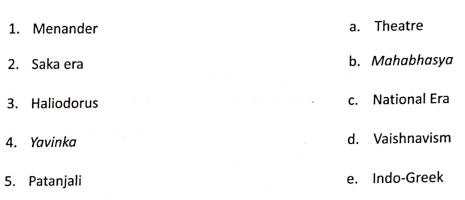A. Tick the correct option.
1. Sakas originally belonged to-
Answer: Central Asia
2. Edict on Girnar mountain is in-
Answer: Junagarh
3. Kushans were defeated by-
Answer: Huns
4. The use of helmets was introduced in India by-
Answer: The Kushans
5. The Gandhar School of Art made images of only-
Answer: Gautam Buddha
B. Fill in the blanks.
1. Grand Dhwaj Pillar was built at ___________ by ___________.
2. ___________ was the most famous Kushan ruler.
3. Stitched clothes and long boots were introduced in India by ___________.
4. ___________ contributed to the development of Indian theatre.
5. Kanishka was the follower of ___________ branch of Buddhism.
Answer: (1) Besnagar, Haliodorus (2) Kanishka (3) Kushans (4) Greeks (5) Mahayana.
C. Match the following:

Answer: (1) e (2) c (3) d (4) a (5) b.
D. Answer the following questions in brief.
1. Where did Menander establish his rule in India?
Answer: Menander establish his rule over Punjab and Kashmir in India.
2. Mention the areas where the contribution of Greeks was very valuable.
Answer: The contribution of Greeks is manifold in the fields of Natyashastra, coinage, sculpture, philosophy and trade.
3. Who were the Kushans? Why did they come to India?
Answer: Kushans belong to the province of Kanes of western China. They were known as Tueh-Chi. They were defeated by the Huns. So, they moved towards India to settle here.
4. Mention five words which have been adopted from Greek and other languages.
Answer: We have adopted many words from Greek and other languages. Example, ‘hora,’ ‘kalam,’ ‘plague, ‘surang, etc.
5. How did the Greeks influence our coinage system?
Answer: The shapes of coins and engraving of self-images, picture on both sides were the influence of Greeks on our coinage system.
E. Answer the following questions.
1. Describe the contribution of the Indo-Greeks.
Answer: The Indo-Greek rulers were the one whose coins carried the portrait of kings and their names. They were the first rulers to issue gold coins. They influenced the Indian Science and astronomy. The Gandhar School of Art was developed under Indo-Greeks.
2. Explain briefly the reforms introduced by Rudradaman.
Answer: The Rudradaman was the most powerful Shaka ruler. Information about his kingdom is provided by the edicts engraved on Girnar mountain in Junagadh (Gujarat). He issued silver coins on which his figure was engraved. In order to provide good irrigation facilities, he repaired the Sudarshan Lake in Kathiavar (Gujarat).
3. How did Greeks influence the fields of science, literature and art of India?
Answer: The Greek influence India in updating their Science and Technology. The term ‘horoscope’ has been derived from the Greek term horasastra. The manufacturing of leather shoes started during this period. He influenced our language and litiature because we have adopted many words from them. He also influenced our art. The Gandhar School of Art and Mathura School of Art were developed during this period. They contributed to the development of Indian theatre.
4. How did the contacts with central Asia influence Indian social life?
Answer: The contacts with central Asia made a deep impact on the Indian societies. Earlier the Indians were using unstitched clothes. The concept of stitched clothes was introduced for the first time. They also influenced the use of helmets.
5. Why is Kanishka famous in Indian history?
Answer: Kanishka was the most powerful Kushan ruler. He famous in Indian history because of following achievements:
- He conquered Kashmir, snatched Punjab and Mathura from Saka.
- He was a great patron of art and litiature.
- He embraced Buddhism.
- He took measures to spread the religion of Buddha to the other lands like Tibet, Japan and Korea.